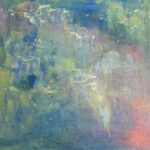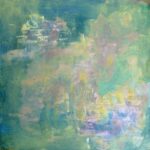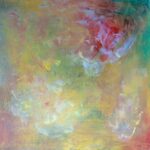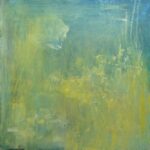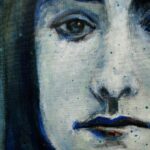Messing with different techniques to try jolt myself out of a rut. Some lazy negative-image linocuts. I managed to take a few chunks out of my finger and remembered why I never pursued this technique more keenly.
So painting hasn’t been going well lately and I’ve been trying to find other ways to make art. I’ve been thinking a lot about sculpture, but the problem with the world of three dimensions is that Nature got there first and totally owns the field. I keep finding these organic structures that are as beautiful and poetic and rich with the capacity for metaphor as any sculpture I’ve ever seen or could ever hope to make myself.
Like these…things. They’re essentially just knots of flotsam that got snagged on branches when the floods came: mostly dead leaves and grass, knitted together into these strange little nests that are strong enough to withstand the current but disintegrate when handled. I’m totally obsessed with them. I try to think of ways to photograph one or recreate it or just claim it like a Duchampian readymade and I can think of plenty of art-historical precedents that I could use to justify whatever I wanted to do. But then again, there’s a little voice in the back of my head saying: “Seriously, that is literally just a piece of crap."
To remind myself of how much I loved drawing as a kid and why I took up art in the first place.
According to the box, Made in Czechoslovakia.
A couple of the least grievous of a series of preliminary sketches for a portrait; to the lovely model I’m afraid these do not in the least do justice.
Pencil, cleaned up digitally.
Can’t talk now. Hugely distracted by Spring.
4 of 4. Oil on wood, 12×12"
3 of 4. Oil on wood, 12×12"
2 of 4. Oil on wood, 12×12"
1 of 4.
I can’t tell if these are finished. Abstract, oil on wood. 12×12"
Detail from a work-in-progress, a portrait of the explorer Alexandra David-Neel, whom I have only discovered lately and am now fascinated with.
David-Neel travelled obsessively, even running away from home several times as a child; she joined several secret societies, feminist and anarchist groups; she studied music and performed on stage in opera houses across Europe; and she spent long hours in libraries studying languages and philosophy. She went to India, Africa and Tunis, where at 36 she met and married a railroad engineer, only to leave him three years later because she couldn’t bear to be a housewife.
She then visited the royal monastery of Sikkim, met the Dalai Lama twice and spent nearly two years in a cave learning Buddhist spirituality with a young monk called Yongden whom she would later adopt. Together they travelled to Japan to avoid the First World War, traversed China on the way back and disguised themselves as pilgrims to enter Lhasa, Tibet. She returned to France for a while and wrote several books. Then, during the Second World War, she and Yongden travelled to the Soviet Union to get back into Tibet one last time.
They returned to France in 1946; Alexandra was 78. Yongden died 9 years later but Alexandra continued to work and study until her death at the age of 101, when her ashes and those of Yongden were mixed together and scattered in the Ganges.
The photo I’m using as reference for this painting was taken when Alexandra was a teenager. When she was young, she was deeply frustrated by her parents’ caution and the restrictions on her freedom, feeling very keenly that life was short and she was being forced to waste it. She would later write the following:
“I cried bitter tears more than once, having the profound feeling that life was going by, that the days of my youth were going by, empty, without interest, without joy. I understood that I was wasting time that would never return, that I was losing hours that could have been beautiful.”
Sometimes I am terribly afraid of how much time I am wasting.
Mixed media (mostly acrylic) on board. 16×20"













